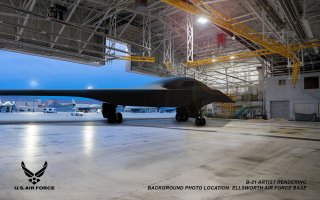America's New B-21 Raider Stealth Bomber: Russia's Worst Nightmare?
Despite the widely discussed growing sophistication of Russian-built air defenses, the task of actually “hitting” an advanced stealth aircraft is extremely difficult.
The Air Force is getting closer to sending its first few B-21 stealth bombers up into the air for testing and early evaluation in preparation for a potential war. As a result, many people are likely wondering whether the new ultra-stealth, secret platform just might succeed in an attempt to evade the most advanced air defenses in the world. Could it be true?
The details of its stealth properties may never fully be known, something which is quite likely for the best; however, a senior Air Force official told me years ago that the B-21 stealth bomber will be able to put any target at risk anywhere in the world at any time. What would it take for this to actually be the case? It would take a lot but it may not be impossible. Perhaps only a test in actual war would answer the question, but it would not be surprising if the Air Force began testing the B-21 against representative models or close approximations of Russian and Chinese air defenses.
While Russian newspapers can at times be given to some hyperbole regarding their weapons systems, state-run publications have, for several years now, claimed that advanced S-400 and S-500 Russian air defenses “can” detect and destroy stealth aircraft. They are increasingly meshed or networked to one another in a way that allows them to transmit tracking data from one digital node to another. Also, they operate with much faster computer processing speed and more sensitive, longer-range radar systems. Additionally, they operate on a broader range of frequencies and can likely share track-loop data between fire-control systems more quickly and efficiently. They may even operate with artificial-intelligence-enabled information targeting systems which use advanced algorithms to bounce incoming images off of known, previously compiled data to make rapid identifications.
However, despite the widely discussed growing sophistication of Russian-built air defenses, the task of actually “hitting” an advanced stealth aircraft is extremely difficult. A much narrower, high-frequency radar system is needed to establish a precise track on a stealth plane as it moves. A greater degree of image fidelity, sensitivity, and precision is needed to maintain a target lock on an aircraft as it transits from one radar aperture or field of view to another. In essence, it may be quite difficult to establish a continuous track, the kind of targeting needed to actually hit and shoot down a stealth aircraft. Hitting an aircraft is quite different than simply being able to make a determination that an aircraft is there or might be there. What this means is that, despite the hype about air defenses, advanced stealth is quite likely here to stay, particularly in the case of the B-21 Raider as it reportedly incorporates an entirely new generation of stealth technologies.
Kris Osborn is the defense editor for the National Interest. Osborn previously served at the Pentagon as a Highly Qualified Expert with the Office of the Assistant Secretary of the Army—Acquisition, Logistics & Technology. Osborn has also worked as an anchor and on-air military specialist at national TV networks. He has appeared as a guest military expert on Fox News, MSNBC, The Military Channel, and The History Channel. He also has a Master’s Degree in Comparative Literature from Columbia University.

